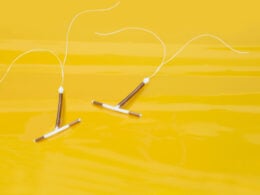There is no more unifying experience among women around the globe than menstruation. All women understand what it feels like to have their period—even if they don’t exactly understand what it is.
And yet, the topic of menstruation continues to hold significant stigmas, and embarrassment or hesitation to discuss this vital function of the female body has created gaps in our knowledge of how the menstrual cycle affects a women’s overall health.
Therefore, it was a welcome shock to discover that the May 2019 issue of Scientific American magazine is primarily dedicated to the science of women’s reproductive health—or rather, the lack thereof. In one particularly revealing article, “What is the Point of a Period?” by Virginia Sole-Smith, the author investigates the long-standing menstrual taboo and the devastating effect it has had on women’s reproductive health, including the unique problem concerning menstrual suppression through hormonal birth control.
Coming from a nationally esteemed scientific magazine as Scientific American (the longest continuously published magazine in the United States), this article is truly a breakthrough for women’s reproductive health, for several reasons.
The medical and scientific repercussions of the global menstruation taboo
All women of child-bearing years experience menstruation. There is nothing strange or unhealthy about it, even if global taboos are still very much alive. In fact, the female menstrual cycle is necessary for reproduction—necessary for human survival. But still, most people are too scared or embarrassed to talk about or even acknowledge it. As Sole-Smith explains, “That aversion has influenced women’s relationships to their own bodies as well as how the medical establishment manages women when things go wrong with their reproductive health.”
Somehow, many doctors still do not understand the intricacies of the menstrual cycle (especially how charting one’s cycle using a Fertility Awareness-Based Method can help diagnose and treat common health problems). Too many doctors don’t realize that periods offer clues that often reveal underlying issues concerning a woman’s reproductive and overall health.
The scientific community has offered very limited help. As Sole-Smith explains, “It is hard to measure how much money is spent on period research, but experts agree the subject is underfunded.”
At the heart of this menstruation taboo is a lack of knowledge and understanding. Many women may know that their period signals the shedding of their uterus’s lining. But what exactly does that mean? Sole-Smith answers this question thoroughly and concisely: “The endometrial lining of the uterus thickens over the course of a woman’s cycle as her estrogen level rises. If none of the eggs she releases at ovulation joins with a sperm and implants in that lining as a fertilized zygote, then levels of estrogen and another hormone called progesterone drop, triggering the uterus to shed the thickened endometrium so it can start fresh in the next cycle.”
Essentially, a woman’s uterus lining thickens every month to prepare for the possibility of a fertilized egg and pregnancy. If the egg does not get fertilized, then the uterus sheds this lining and it leaves the body as menstrual blood.
While scientists are still struggling to understand exactly what menstrual blood is, Sole-Smith writes that “Even less is known about why so many women—up to 80 percent by some estimates—experience cramps, bloating, fatigue, anger, or other symptoms just before the onset of menstruation.” She quotes Tomi-Ann Roberts, president of the Society for Menstrual Cycle Research, who reveals that “We know so little about menstruation. . . . Because of this, our attitudes toward menstruation are overwhelmingly negative. This has real consequences for how we can begin to understand healthy menstruation, as well as menstruation-related disorders and the treatment options available.”
In another article in this same issue of Scientific American, “Fertile Ground: The Long-Neglected Science of Female Reproductive Health,” author Clara Moskowitz writes:
“Having periods is not a disease. But when they go wrong, they offer clues into disorders that require intervention. The medical field has largely done a poor job of identifying and treating them with precision. Clinicians tend to wield synthetic hormones like a hammer, liberally prescribing the birth-control pill for all kinds of pain—which is partly why serious diseases of the female organs such as endometriosis take an average of eight years to be diagnosed. That women’s symptoms are often dismissed does not help.”
Which brings us to the question of why doctors started covering up the female menstrual cycle via hormonal birth control in the first place, and why they are just now—decades later—starting to adequately research the effects of menstrual suppression.
The problem of birth control’s long-term suppression of menstruation
In her article, Sole-Smith explains how research on menstruation evolved from ludicrous conclusions “that menstrual blood contained a kind of poison” in 1920 to research on how to prevent pregnancies in the 1950s in large part to the work of Margaret Sanger (future founder of Planned Parenthood). In the first large-scale, FDA-approved trial of hormonal birth control, 265 low-income Puerto Rican women were recruited (as Sole-Smith notes, “without the level of ‘informed consent’ required today”), and 22% of the women dropped out of the experiment after experiencing adverse side effects. “The study’s medical director argued that the pill ‘caused too many side reactions to be generally acceptable.’ Nevertheless, it went to market.”
This is how birth control came to be—tested on poor women in another country without proper consent, with their blatant side effects brushed aside. While the Pill is celebrated as a liberating breakthrough for women, Sole-Smith goes on to explain: “But liberation came with a price. By the late 1960s patients across the U.S. were reporting the same symptoms documented during the Puerto Rican trial. Despite many reformulations over the ensuing decades, side effects remain a problem for many women on the pill; risks for breast cancer, blood clots and stroke may also be higher.”
Elizabeth Kissling, a professor of women and gender studies at Eastern Washington University, explains how this new “reproductive freedom” did not seem to take into consideration the consequences of “shutting down a woman’s natural cycle.” Sole-Smith sums it up well: “scientists figured out how to supplant periods long before they began trying to understand why they work the way they do.”
The article explains how scientists did not truly investigate “the larger question of why menstruation happens at all” until the late 1980s. She explains the research of evolutionary biologist, Beverly I. Strassmann, including her investigation into why humans do not reabsorb their menstrual blood like other animals do, stating: “Our physiology doesn’t permit reabsorption, so much of the blood gets discharged as menstruation.” This led her to conclude that bleeding during one’s menstrual cycle is “an insignificant by-product of evolution rather than an advantage.”
Does that mean a woman’s cycle is insignificant, and should be suppressed by artificial birth control? After all, Sole-Smith notes that “Skipping that monthly ordeal can mean avoiding debilitating pain . . . and other symptoms that can dramatically impair a woman’s quality of life.” But as Kissling notes, “The pill isn’t a treatment for these conditions. It’s a way of refusing to treat them.” Endocrinologist Jerilynn Prior explains how “it can take up to a decade or longer from disease onset for a woman to be diagnosed with endometriosis, for example, in part because doctors are so quick to prescribe the drug to teenagers reporting bad cramps without investigating to see if there is an underlying cause.” The Pill masks often serious underlying problems and manipulates natural hormone functions.
Reason for concern
Strassmann, for one, is rightly skeptical about the long-term effects of “medically induced menstrual suppression”—namely, the higher hormone levels with which women become exposed. She says, “It’s true a monthly menstrual period is not necessary. But taking more progestin to skip your period is not living like our ancestors did 500 or 1,000 years ago.”
As the article “What is the Point of a Period” reveals, “analyzing data from 12 studies, as well as the information on birth-control package inserts, Strassmann’s team concluded that some types of the Pill exposed women to a quadruple dose of progestin (a synthetic form of progesterone contained in the Pill), relative to the progesterone their naturally cycling body would produce.”
Ultimately, this crucial article reveals that what we know about menstruation and the long-term effects of birth control on menstruation is that we still don’t know enough. Sole-Smith explains, “Nobody knows for sure what that exposure to synthetic hormones will mean long term for women using the Pill to suppress their cycles indefinitely. This knowledge gap speaks to broader concerns about our ignorance around menstruation.” And if this is not concerning, then I do not know what is.
What I do know is that I do not want to be part of this experiment. I find myself asking the same questions that Moskowitz poses, “What might be different if researchers had investigated the evolutionary purpose of periods before they developed a Pill to shut down a woman’s cycle? Why are women expected to shoulder health trade-offs in exchange for avoiding pregnancy?”
I find it tragic that more women do not see their menstrual cycle and fertility as a vital sign of health and that they are not given adequate information by their doctors about their cycle and natural options for family planning and treatment of common health issues, other than birth control. Too many women are not given the option of—or even information on—safe, natural, side-effect-free, Fertility Awareness-Based Methods, modern methods based in science.
In a closing sentence that left me with chills, Kissing suggests that “Long-term menstrual suppression via birth control is the largest uncontrolled medical experiment on women in history.” Here’s to stopping experiments when it comes to women’s health.











